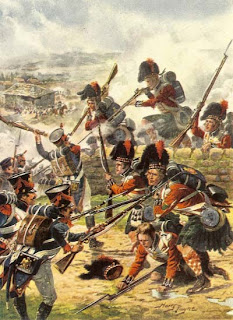 With apologies to ZZ Top–I couldn’t resist! Anyway, I’d like to share some more tidbits from LIFE IN WELLINGTON’S ARMY, with thanks to Antony Brett-James for helping us all create our hot military heroes.
With apologies to ZZ Top–I couldn’t resist! Anyway, I’d like to share some more tidbits from LIFE IN WELLINGTON’S ARMY, with thanks to Antony Brett-James for helping us all create our hot military heroes.
This time it’s about the uniforms. Wellington, nicknamed ‘the Beau’, dressed well himself. “Larpent says he had the skirts of his coats cut shorter in the Peninsula to make them look smarter, and one day in 1813 he found Wellington discussing with his servant the cut of his half-boots and suggesting alterations.” However, Wellington didn’t fuss about his army’s attire. Grattan of the Connought Rangers wrote: “Provided we brought our men into the field well appointed, and with sixty rounds of good ammunition each, he never looked to see whether their trousers were black, blue or gray; and as to ourselves, we might be rigged out in all colours of the rainbow if we fancied it. The consequence was, that scarcely any two officers were dressed alike! Some with grey braided coats, others with brown; some again liked blue; while many from choice, or perhaps necessity, stuck to the ‘old red rag’.”
 I was interested to learn that some regiments wore kilts, which “did not always prove to be practical garment for campaign life. While advancing to the heights of Puebla during the Battle of Vitoria, the 92nd had to cross ditches so thickly lined with thorns and briars that the blood ran trickling down many a soldier’s leg.” By 1814 the Black Watch was the only regiment still wearing the kilt.
I was interested to learn that some regiments wore kilts, which “did not always prove to be practical garment for campaign life. While advancing to the heights of Puebla during the Battle of Vitoria, the 92nd had to cross ditches so thickly lined with thorns and briars that the blood ran trickling down many a soldier’s leg.” By 1814 the Black Watch was the only regiment still wearing the kilt.
Wear and tear and dust played havoc with uniforms. One day in 1808 Captain Landemann of the Engineers and Major-General Henry Fane were riding side by side and observed there was little difference between their coats; the former was originally blue, the latter red. Another observer described how red coats deteriorated to something “as ragged as sheep and as black as rooks.”
Here is Captain Mercer’s description of the troops parading in Paris after Waterloo:
“The colour had faded to a dusky brick-dust hue; their coats, originally not very smartly made, had acquired by constant wearing that loose easy set so characteristic of old clothes, comfortable to the wearer, but not calculated to add grace to his appearance.”
A French student watching the same review wrote: ‘Oh! It was really like being defeated twice over, bis mori, to have been beaten by an army so badly turned out as the English army was…How could one be a good soldier under that little sugar-loaf of a peak, with the inelegantly cut red jacket, those grey trousers clinging to knock-knees?”
 As for me, I’m not so turned off by a scruffy exterior. On the other hand, there’s nothing wrong with a dandy hero either—dandies have an understanding of pleasure and luxury that can be very sexy. I like variety in my fantasy men. I’ve got one dandy in my idea file. Still, I’ve got a slight preference for heroes who are active and look it. And I’d mend Richard Sharpe’s shirts any time! 🙂
As for me, I’m not so turned off by a scruffy exterior. On the other hand, there’s nothing wrong with a dandy hero either—dandies have an understanding of pleasure and luxury that can be very sexy. I like variety in my fantasy men. I’ve got one dandy in my idea file. Still, I’ve got a slight preference for heroes who are active and look it. And I’d mend Richard Sharpe’s shirts any time! 🙂
How about you? Do you prefer your Regency heroes nattily turned out or on the rugged side?
Elena
www.elenagreene.com








